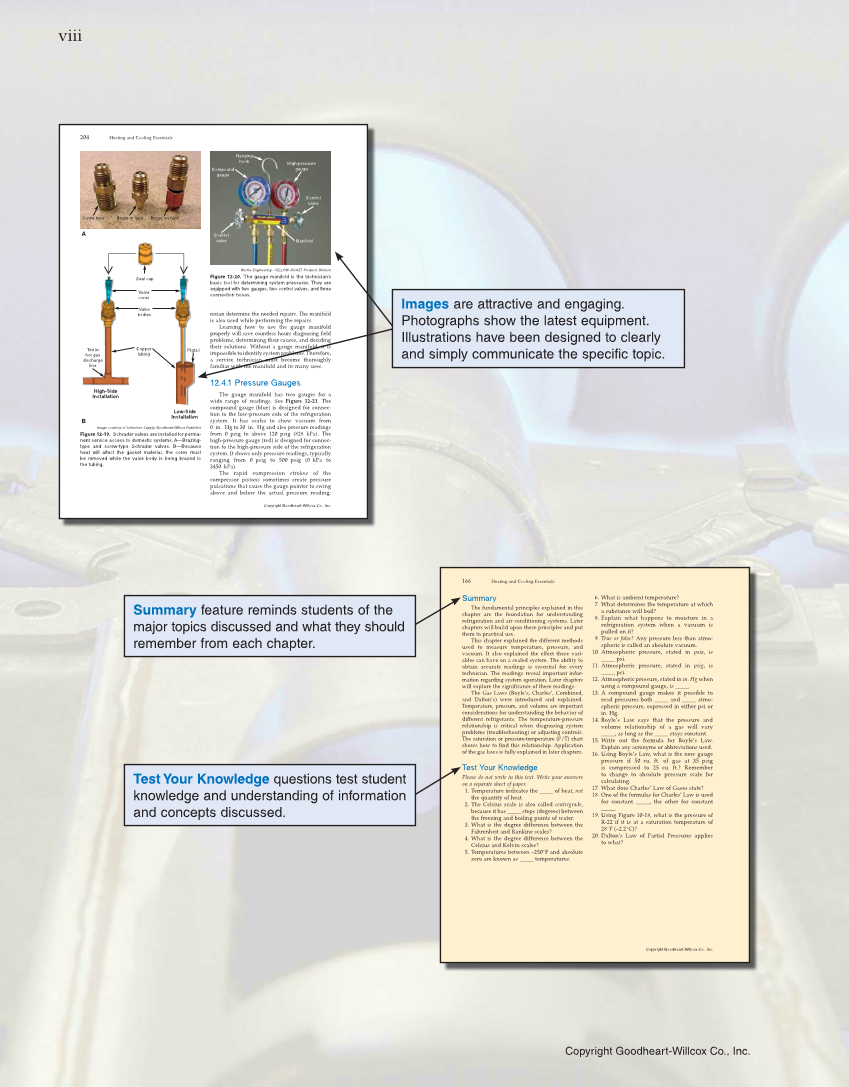Summary The fundamental principles explained in this chapter are the foundation for understanding refrigeration and air conditioning systems. Later chapters will build upon these principles and put them to practical use. This chapter explained the different methods used to measure temperature, pressure, and vacuum. It also explained the effect these vari- ables can have on a sealed system. The ability to obtain accurate readings is essential for every technician. The readings reveal important infor- mation regarding system operation. Later chapters will explore the significance of these readings. The Gas Laws (Boyle’s, Charles’, Combined, and Dalton’s) were introduced and explained. Temperature, pressure, and volume are important considerations for understanding the behavior of different refrigerants. The temperature-pressure relationship is critical when diagnosing system problems (troubleshooting) or adjusting controls. The saturation or pressure-temperature (P/T) chart shows how to find this relationship. Application of the gas laws is fully explained in later chapters. Test Your Knowledge Please do not write in this text. Write your answers on a separate sheet of paper. 1. Temperature indicates the _____ of heat, not the quantity of heat. 2. The Celsius scale is also called centrigrade, because it has _____ steps (degrees) between the freezing and boiling points of water. 3. What is the degree difference between the Fahrenheit and Rankine scales? 4. What is the degree difference between the Celsius and Kelvin scales? 5. Temperatures between –250°F and absolute zero are known as _____ temperatures. 6. What is ambient temperature? 7. What determines the temperature at which a substance will boil? 8. Explain what happens to moisture in a refrigeration system when a vacuum is pulled on it? 9. True or false? Any pressure less than atmo- spheric is called an absolute vacuum. 10. Atmospheric pressure, stated in psia, is _____ psi. 11. Atmospheric pressure, stated in psig, is _____ psi. 12. Atmospheric pressure, stated in in. Hg when using a compound gauge, is _____. 13. A compound gauge makes it possible to read pressures both _____ and _____ atmo- spheric pressure, expressed in either psi or in. Hg. 14. Boyle’s Law says that the pressure and volume relationship of a gas will vary _____, as long as the _____ stays constant. 15. Write out the formula for Boyle’s Law. Explain any acronyms or abbreviations used. 16. Using Boyle’s Law, what is the new gauge pressure if 50 cu. ft. of gas at 35 psig is compressed to 25 cu. ft.? Remember to change to absolute pressure scale for calculating. 17. What does Charles’ Law of Gases state? 18. One of the formulas for Charles’ Law is used for constant _____, the other for constant _____. 19. Using Figure 10-18, what is the pressure of R-22 if it is at a saturation temperature of 28°F (–2.2°C)? 20. Dalton’s Law of Partial Pressures applies to what? 166 Heating and Cooling Essentials Copyright Goodheart-Willcox Co., Inc. Ch10.indd 166 10/24/2014 3:02:06 PM nician determine the needed repairs. The manifold is also used while performing the repairs. Learning how to use the gauge manifold properly will save countless hours diagnosing field problems, determining their causes, and deciding their solutions. Without a gauge manifold, it is impossible to identify system problems. Therefore, a service technician must become thoroughly familiar with the manifold and its many uses. 12.4.1 Pressure Gauges The gauge manifold has two gauges for a wide range of readings. See Figure 12-21. The compound gauge (blue) is designed for connec- tion to the low-pressure side of the refrigeration system. It has scales to show vacuum from 0 in. Hg to 30 in. Hg and also pressure readings from 0 psig to above 120 psig (828 kPa). The high-pressure gauge (red) is designed for connec- tion to the high-pressure side of the refrigeration system. It shows only pressure readings, typically ranging from 0 psig to 500 psig (0 kPa to 3450 kPa). The rapid compression strokes of the compressor pistons sometimes create pressure pulsations that cause the gauge pointer to swing above and below the actual pressure reading. Seal cap Valve cores Valve bodies Copper tubing Pigtail Tee in hot gas discharge line High-Side Installation Low-Side Installation Screw type Braze in type Braze on type A B Image courtesy of Johnstone Supply Goodheart-Willcox Publisher Figure 12-19. Schrader valves are installed for perma- nent service access to domestic systems. A—Brazing- type and screw-type Schrader valves. B—Because heat will affect the gasket material, the cores must be removed while the valve body is being brazed to the tubing. Hanging hook Compound gauge High-pressure gauge Control valve Control valve Manifold Ritchie Engineering – YELLOW JACKET Products Division Figure 12-20. The gauge manifold is the technician’s basic tool for determining system pressures. They are equipped with two gauges, two control valves, and three connection hoses. 204 Heating and Cooling Essentials Copyright Goodheart-Willcox Co., Inc. Ch12.indd 204 10/24/2014 10:35:59 AM Images are attractive and engaging. Photographs show the latest equipment. Illustrations have been designed to clearly and simply communicate the specific topic. Summary feature reminds students of the major topics discussed and what they should remember from each chapter. Test Your Knowledge questions test student knowledge and understanding of information and concepts discussed. viii Copyright Goodheart-Willcox Co., Inc.
